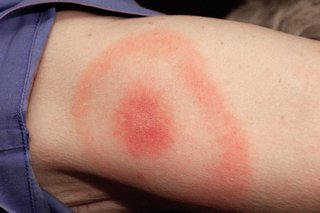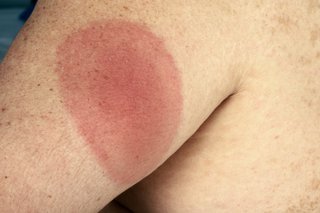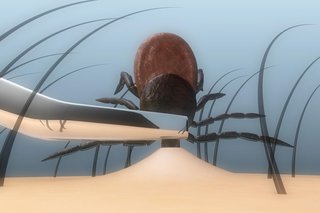Lyme disease is a bacterial infection that can be spread to humans by infected ticks. It's usually easier to treat if it's diagnosed early.
Symptoms of Lyme disease
Most people with early symptoms of Lyme disease develop a circular red rash around a tick bite.
The rash can appear up to 3 months after being bitten by a tick. Most rashes appear within the first 4 weeks. It usually lasts for several weeks.
Not everyone with Lyme disease gets the rash.


In the early stages you may also have flu-like symptoms such as:
- feeling hot and shivery, or a high temperature
- headaches
- muscle and joint pain
- tiredness and loss of energy
Most tick bites are harmless
Only a small number of ticks are infected with the bacteria that cause Lyme disease. A tick bite can only cause Lyme disease in humans if the tick has bitten an infected animal.
Important
Remove ticks as soon as possible - Lyme disease can be prevented if infected ticks are removed within 36 hours.
About 5% of ticks in Ireland are thought to carry Lyme disease bacteria.
Be aware of high-risk areas, which include:
- grassy and wooded areas
- sand dunes
How to remove ticks
Tick bites are not always painful. You may not notice a tick unless you see it on your skin.
Check your skin after being outdoors.
Also check your children for ticks, especially their head and hairline.
Pets can carry the ticks and need to be checked as well.
Use fine-tipped tweezers or a tick-removal tool. You can buy these from some pharmacies, vets and pet shops.
3 steps to removing a tick safely
- Grasp the tick as close to the skin as possible.
- Slowly pull upwards, taking care not to squeeze or crush the tick - dispose of it carefully.
- Clean the bite with antiseptic or soap and water.
Ways to dispose of a tick include:
- putting it in alcohol
- placing it in a sealed bag or container
- wrapping it tightly in tape
- flushing it down the toilet

When to see a GP
The risk of getting ill after a tick bite is low. But early treatment can prevent Lyme disease.
Non-urgent advice: Contact your GP if
you have symptoms of Lyme disease such as a rash or fever and you:
- were bitten by a tick
- spent time in woods or areas with long grass, but did not notice a tick
Diagnosing Lyme disease
Lyme disease can be difficult to diagnose. It has similar symptoms to other conditions and there is not always an obvious rash.
Blood tests help confirm or rule out Lyme disease. But these tests are not always accurate in the early stages of the disease.
Sometimes you will need to have the blood test repeated.
Treatment of Lyme disease
Your GP will prescribe antibiotics if they think you have Lyme disease.
They may refer you to hospital if your symptoms are severe and you need antibiotics through a drip (intravenously).
Most people with Lyme disease get better after antibiotic treatment. It can take months for some people. But the symptoms should improve over time.
Some websites offer tests and treatment for Lyme disease. Speak to your GP before buying tests or treatment online.
How to prevent tick bites
To reduce the risk of being bitten:
- cover your skin while walking outdoors and tuck your trousers into your socks
- use insect repellent on your clothes and skin - products containing DEET are best
- stick to paths whenever possible
- wear light-coloured clothing so ticks are easier to spot and brush off
Ongoing symptoms
Some people who are diagnosed and treated for Lyme disease continue to have symptoms. For example, tiredness, aches and loss of energy. But this is rare.
It's not clear why this happens to some people and not others.
Talk to your GP if your symptoms come back after treatment with antibiotics or if they do not improve.
Content supplied by the NHS and adapted for Ireland by the HSE
